Machine Learning Modeling for Energy Consumption of Residential and Commercial Sectors
Abstract
1. Introduction
- Residential and commercial energy consumption will increase up to 76.97 Mtoe in 2040, according to NARX model forecasting.
- NARX artificial neural network has higher accuracy than logarithmic multiple linear regression and multiple linear regressions.
- The developed NARX model is applicable for forecasting energy consumption with high precision in different energy sectors.
- Population, gross domestic production and renewable energy share in final consumption are the most dominant factors in residential and commercial energy consumption.
- Increase in renewable energy share in final consumption will lead the reduction in energy consumption for residential and commercial sectors.
2. Background
2.1. Bottom-Up
2.2. Top-Down
2.3. Artificial Neural Network
3. Data Evaluation and Variable Trend Analysis
3.1. Population
3.2. Gross Domestic Production
3.3. Natural Gas Price
3.4. Electricity Price
3.5. Share of Renewable Energy Sources in Final Energy Consumption
4. Methodology
4.1. Multiple Linear Regression (MLR) and Logarithmic Multiple Linear Regression(LMLR) Models
4.2. Nonlinear AutoregRessive with eXogenous Input: NARX Model
5. Results and Discussion
5.1. Model Analyzing Measures
5.2. MLR
5.3. LMLR
5.4. ANN
5.5. Model Evaluation
6. Conclusions
Author Contributions
Funding
Acknowledgments
Conflicts of Interest
References
- Zanjirchi, S.M.; Shojaei, S.; Sadrabadi, A.N.; Jalilian, N. Promotion of solar energies usage in Iran: A scenario-based road map. Renew. Energy 2020, 150, 278–292. [Google Scholar] [CrossRef]
- Samadi, S.H.; Ghobadian, B.; Nosrati, M. Prediction and estimation of biomass energy from agricultural residues using air gasification technology in Iran. Renew. Energy 2020, 149, 1077–1091. [Google Scholar] [CrossRef]
- Fayaz, M.; Shah, H.; Aseere, A.M.; Mashwani, W.K.; Shah, A.S. A framework for prediction of household energy consumption using feed forward back propagation neural network. Technologies 2019, 7, 30. [Google Scholar] [CrossRef]
- International Institute for Sustainable Development (IISD). Global Energy Demand in 2018 Grew at Fastest Pace in a Decade. Available online: https://sdg.iisd.org/news/global-energy-demand-in-2018-grew-at-fastest-pace-in-a-decade/ (accessed on 26 August 2020).
- Amber, K.P.; Aslam, M.W.; Mahmood, A.; Kousar, A.; Younis, M.Y.; Akbar, B.; Chaudhary, G.Q.; Hussain, S.K. Energy consumption forecasting for university sector buildings. Energies 2017, 10, 1579. [Google Scholar] [CrossRef]
- IEA. Iran—Countries & Regions—IEA. Available online: https://www.iea.org/countries/Iran (accessed on 7 July 2020).
- Hossein Motlagh, N.; Mohammadrezaei, M.; Hunt, J.; Zakeri, B. Internet of Things (IoT) and the energy sector. Energies 2020, 13, 494. [Google Scholar] [CrossRef]
- Motlagh, N.H.; Khajavi, S.H.; Jaribion, A.; Holmstrom, J. An iot-based automation system for older homes: A use case for lighting system. In Proceedings of the 2018 IEEE 11th Conference on Service-Oriented Computing and Applications (SOCA), Paris, France, 20–22 November 2018; pp. 1–6. [Google Scholar]
- Nejat, P.; Jomehzadeh, F.; Taheri, M.M.; Gohari, M.; Majid, M.Z.A. A global review of energy consumption, CO2 emissions and policy in the residential sector (with an overview of the top ten CO2 emitting countries). Renew. Sustain. Energy Rev. 2015, 43, 843–862. [Google Scholar] [CrossRef]
- Hall, L.M.; Buckley, A.R. A review of energy systems models in the UK: Prevalent usage and categorisation. Appl. Energy 2016, 169, 607–628. [Google Scholar] [CrossRef]
- Pourvahidi, P.; Ozdeniz, M.B. Bioclimatic analysis of Iranian climate for energy conservation in architecture. Sci. Res. Essays 2013, 8, 6–16. [Google Scholar]
- Mehri, N.; Messkoub, M.; Kunkel, S. Trends, determinants and the implications of population aging in Iran. Ageing Int. 2020, 1–17. Available online: https://doi.org/10.1007/s12126-020-09364-z (accessed on 7 July 2020).
- Kim, M.; Jung, S.; Kang, J.W. Artificial Neural Network-Based Residential Energy Consumption Prediction Models Considering Residential Building Information and User Features in South Korea. Sustainability 2020, 12, 109. [Google Scholar] [CrossRef]
- Runge, J.; Zmeureanu, R. Forecasting energy use in buildings using artificial neural networks: A review. Energies 2019, 12, 3254. [Google Scholar] [CrossRef]
- Amjadi, M.; Nezamabadi-Pour, H.; Farsangi, M. Estimation of electricity demand of Iran using two heuristic algorithms. Energy Convers. Manag. 2010, 51, 493–497. [Google Scholar] [CrossRef]
- Pahlavan, S.; Jahangiri, M.; Shamsabadi, A.A.; Baharizadeh, A. Assessing the Current Status of Renewable Energies and Their Limitations in Iran. Int. J. Renew. Energy Dev. 2020, 9, 97–105. [Google Scholar] [CrossRef]
- Li, Z.; Han, Y.; Xu, P. Methods for benchmarking building energy consumption against its past or intended performance: An overview. Appl. Energy 2014, 124, 325–334. [Google Scholar] [CrossRef]
- Shahmoradi, A.; Shakouri, H. Investigation On The Impact Of An Energy De-subsidization Shock On The General Price Index Via A Nonlinear Inflation Model: Case Of Iran. Iran. Econ. Rev. 2010, 15, 33–51. [Google Scholar]
- Shakouri, H.; Kazemi, A. Selection of the best ARMAX model for forecasting energy demand: Case study of the residential and commercial sectors in Iran. Energy Effic. 2016, 9, 339–352. [Google Scholar] [CrossRef]
- Omrany, H.; Marsono, A.K. National building regulations of Iran benchmarked with Breeam and Leed: A comparative analysis for regional adaptations. Curr. J. Appl. Sci. Technol. 2016, 16, 1–15. [Google Scholar] [CrossRef]
- Suganthi, L.; Samuel, A.A. Energy models for demand forecasting—A review. Renew. Sustain. Energy Rev. 2012, 16, 1223–1240. [Google Scholar] [CrossRef]
- Swan, L.G.; Ugursal, V.I. Modeling of end-use energy consumption in the residential sector: A review of modeling techniques. Renew. Sustain. Energy Rev. 2009, 13, 1819–1835. [Google Scholar] [CrossRef]
- Laha, P.; Chakraborty, B. Energy model—A tool for preventing energy dysfunction. Renew. Sustain. Energy Rev. 2017, 73, 95–114. [Google Scholar] [CrossRef]
- Da Silva, F.L.; Souza, R.C.; Oliveira, F.L.C.; Lourenço, P.M.; de C. Fagundes, W. Forecast of long-term electricity consumption of the industrial sub-sector of pulp and paper in Brazil using a bottom-up approach. Procedia Comput. Sci. 2015, 55, 514–522. [Google Scholar] [CrossRef]
- Cayla, J.M.; Maizi, N.; Marchand, C. The role of income in energy consumption behaviour: Evidence from French households data. Energy Policy 2011, 39, 7874–7883. [Google Scholar] [CrossRef]
- Min, J.; Hausfather, Z.; Lin, Q.F. A high-resolution statistical model of residential energy end use characteristics for the United States. J. Ind. Ecol. 2010, 14, 791–807. [Google Scholar] [CrossRef]
- Moshiri, S.; Atabi, F.; Panjehshahi, M.H.; Lechtenböehmer, S. Long run energy demand in Iran: A scenario analysis. Int. J. Energy Sect. Manag. 2012, 6, 120–144. [Google Scholar] [CrossRef]
- Motlagh, N.H.; Zaidan, M.A.; Lagerspetz, E.; Varjonen, S.; Toivonen, J.; Mineraud, J.; Rebeiro-Hargrave, A.; Siekkinen, M.; Hussein, T.; Nurmi, P.; et al. Indoor air quality monitoring using infrastructure-based motion detectors. In Proceedings of the 2019 IEEE 17th International Conference on Industrial Informatics (INDIN), Helsinki-Espoo, Finland, 23–25 July 2019; Volume 1, pp. 902–907. [Google Scholar]
- Farzan, F.; Jafari, M.A.; Gong, J.; Farzan, F.; Stryker, A. A multi-scale adaptive model of residential energy demand. Appl. Energy 2015, 150, 258–273. [Google Scholar] [CrossRef]
- Fan, H.; MacGill, I.; Sproul, A. Statistical analysis of driving factors of residential energy demand in the greater Sydney region, Australia. Energy Build. 2015, 105, 9–25. [Google Scholar] [CrossRef]
- Dai, H.; Mischke, P.; Xie, X.; Xie, Y.; Masui, T. Closing the gap? Top-down versus bottom-up projections of China’s regional energy use and CO2 emissions. Appl. Energy 2016, 162, 1355–1373. [Google Scholar] [CrossRef]
- Palapanyakul, K.; Siripongwutikorn, P. Prediction model of short-term electrical load in an air conditioning environment. In Proceedings of the 2017 International Electrical Engineering Congress (iEECON), Pattaya, Thailand, 8–10 March 2017; pp. 1–4. [Google Scholar]
- Mustapa, R.F.; Dahlan, N.Y.; Yassin, A.I.M.; Nordin, A.H.M. Quantification of energy savings from an awareness program using NARX-ANN in an educational building. Energy Build. 2020, 215, 109899. [Google Scholar] [CrossRef]
- Brandt, A.R.; Dale, M.; Barnhart, C.J. Calculating systems-scale energy efficiency and net energy returns: A bottom-up matrix-based approach. Energy 2013, 62, 235–247. [Google Scholar] [CrossRef]
- Ozturk, H.K.; Canyurt, O.E.; Hepbasli, A.; Utlu, Z. Residential-commercial energy input estimation based on genetic algorithm (GA) approaches: An application of Turkey. Energy Build. 2004, 36, 175–183. [Google Scholar] [CrossRef]
- Bianco, V.; Manca, O.; Nardini, S. Electricity consumption forecasting in Italy using linear regression models. Energy 2009, 34, 1413–1421. [Google Scholar] [CrossRef]
- MohammadZadeh, S.; Masoumi, A.A. Modeling residential electricity demand using neural network and econometrics approaches. In Proceedings of the 40th International Conference on Computers & Indutrial Engineering, Awaji Island, Japan, 26–28 July 2010; pp. 1–6. [Google Scholar]
- Siller, T.; Kost, M.; Imboden, D. Long-term energy savings and greenhouse gas emission reductions in the Swiss residential sector. Energy Policy 2007, 35, 529–539. [Google Scholar] [CrossRef]
- Shabani, Z.D.; Shahnazi, R. Energy consumption, carbon dioxide emissions, information and communications technology, and gross domestic product in Iranian economic sectors: A panel causality analysis. Energy 2019, 169, 1064–1078. [Google Scholar] [CrossRef]
- Forouzanfar, M.; Doustmohammadi, A.; Menhaj, M.B.; Hasanzadeh, S. Modeling and estimation of the natural gas consumption for residential and commercial sectors in Iran. Appl. Energy 2010, 87, 268–274. [Google Scholar] [CrossRef]
- Ahmadvand, A.; Ghaderi, S.; Boustanpour, H. The analysis of residential energy consumption in Iran using system dynamic. In Proceedings of the 2010 IEEE Second International Conference on Computer Modeling and Simulation, Sanya, China, 22–24 January 2010; Volume 3, pp. 290–294. [Google Scholar]
- Murat, Y.S.; Ceylan, H. Use of artificial neural networks for transport energy demand modeling. Energy Policy 2006, 34, 3165–3172. [Google Scholar] [CrossRef]
- Boghetti, R.; Fantozzi, F.; Kämpf, J.H.; Salvadori, G. Understanding the performance gap: A machine learning approach on residential buildings in Turin, Italy. J. Phys. Conf. Ser. 2019, 1343, 012042. [Google Scholar] [CrossRef]
- Abiodun, O.I.; Jantan, A.; Omolara, A.E.; Dada, K.V.; Mohamed, N.A.; Arshad, H. State-of-the-art in artificial neural network applications: A survey. Heliyon 2018, 4, e00938. [Google Scholar] [CrossRef] [PubMed]
- Zaidan, M.A.; Wraith, D.; Boor, B.E.; Hussein, T. Bayesian proxy modelling for estimating black carbon concentrations using white-box and black-box models. Appl. Sci. 2019, 9, 4976. [Google Scholar] [CrossRef]
- Zaidan, M.A.; Motlagh, N.H.; Fung, P.L.; Lu, D.; Timonen, H.; Kuula, J.; Niemi, J.V.; Tarkoma, S.; Petaja, T.; Kulmala, M.; et al. Intelligent Calibration and Virtual Sensing for Integrated Low-Cost Air Quality Sensors. IEEE Sens. J. 2020. [Google Scholar] [CrossRef]
- Zaidan, M.; Haapasilta, V.; Relan, R.; Junninen, H.; Aalto, P.; Kulmala, M.; Laurson, L.; Foster, A. Predicting atmospheric particle formation days by Bayesian classification of the time series features. Tellus B Chem. Phys. Meteorol. 2018, 70, 1–10. [Google Scholar] [CrossRef]
- Zaidan, M.A.; Dada, L.; Alghamdi, M.A.; Al-Jeelani, H.; Lihavainen, H.; Hyvärinen, A.; Hussein, T. Mutual information input selector and probabilistic machine learning utilisation for air pollution proxies. Appl. Sci. 2019, 9, 4475. [Google Scholar] [CrossRef]
- Tkáč, M.; Verner, R. Artificial neural networks in business: Two decades of research. Appl. Soft Comput. 2016, 38, 788–804. [Google Scholar] [CrossRef]
- Alanis, A.Y.; Arana-Daniel, N.; Lopez-Franco, C. Artificial Neural Networks for Engineering Applications; Academic Press: Cambridge, MA, USA, 2019. [Google Scholar]
- Zaidan, M.A.; Canova, F.F.; Laurson, L.; Foster, A.S. Mixture of clustered Bayesian neural networks for modeling friction processes at the nanoscale. J. Chem. Theory Comput. 2017, 13, 3–8. [Google Scholar] [CrossRef] [PubMed]
- Rodrigues, F.; Cardeira, C.; Calado, J. Neural networks applied to short term load forecasting: A case study. In Smart Energy Control Systems for Sustainable Buildings; Springer: Berlin/Heidelberg, Germany, 2017; pp. 173–197. [Google Scholar]
- Ali, S.; Hasanien, H.M.; Al-Ammar, E.A. Application of an adaptive artificial neural network controller for improving the dynamic response of doubly fed induction generators-based wind farm. J. Bioinform. Intell. Control 2013, 2, 83–91. [Google Scholar] [CrossRef]
- Muyeen, S.; Hasanien, H.M.; Al-Durra, A. Transient stability enhancement of wind farms connected to a multi-machine power system by using an adaptive ANN-controlled SMES. Energy Convers. Manag. 2014, 78, 412–420. [Google Scholar] [CrossRef]
- Dong, Q.; Xing, K.; Zhang, H. Artificial neural network for assessment of energy consumption and cost for cross laminated timber office building in severe cold regions. Sustainability 2018, 10, 84. [Google Scholar] [CrossRef]
- Beyca, O.F.; Ervural, B.C.; Tatoglu, E.; Ozuyar, P.G.; Zaim, S. Using machine learning tools for forecasting natural gas consumption in the province of Istanbul. ENergy Econ. 2019, 80, 937–949. [Google Scholar] [CrossRef]
- Paluszek, M.; Thomas, S. Practical MATLAB Deep Learning: A Project-Based Approach; Apress: New York, NY, USA, 2020. [Google Scholar]
- Poznyak, T.I.; Chairez Oria, I.; Poznyak, A.S. Chapter3-Background on dynamic neural networks. In Ozonation and Biodegradation in Environmental Engineering; Poznyak, T.I., Chairez Oria, I., Poznyak, A.S., Eds.; Elsevier: Amsterdam, The Netherlands, 2019; pp. 57–74. [Google Scholar] [CrossRef]
- Haouraji, C.; Boujnah, M.; Farchi, A.; Mounir, I. Forecast of Electrical Energy Consumption in Residential Sector of Morocco. In Proceedings of the 2017 International Renewable and Sustainable Energy Conference (IRSEC), Tangier, Morocco, 4–7 December 2017; pp. 1–6. [Google Scholar]
- Biswas, M.R.; Robinson, M.D.; Fumo, N. Prediction of residential building energy consumption: A neural network approach. Energy 2016, 117, 84–92. [Google Scholar] [CrossRef]
- Safa, M.; Safa, M.; Allen, J.; Shahi, A.; Haas, C.T. Improving sustainable office building operation by using historical data and linear models to predict energy usage. Sustain. Cities Soc. 2017, 29, 107–117. [Google Scholar] [CrossRef]
- Ekonomou, L. Greek long-term energy consumption prediction using artificial neural networks. Energy 2010, 35, 512–517. [Google Scholar] [CrossRef]
- Ardakani, S.R.; Hossein, S.M.; Aslani, A. Statistical approaches to forecasting domestic energy consumption and assessing determinants: The case of Nordic countries. Strateg. Plan. Energy Environ. 2018, 38, 26–71. [Google Scholar] [CrossRef]
- Yin, Z.; Jia, B.; Wu, S.; Dai, J.; Tang, D. Comprehensive forecast of urban water-energy demand based on a neural network model. Water 2018, 10, 385. [Google Scholar] [CrossRef]
- Szoplik, J. Forecasting of natural gas consumption with artificial neural networks. Energy 2015, 85, 208–220. [Google Scholar] [CrossRef]
- Chae, Y.T.; Horesh, R.; Hwang, Y.; Lee, Y.M. Artificial neural network model for forecasting sub-hourly electricity usage in commercial buildings. Energy Build. 2016, 111, 184–194. [Google Scholar] [CrossRef]
- Protić, M.; Fathurrahman, F.; Raos, M. Modelling energy consumption of the republic of Serbia using linear regression and artificial neural network technique. Tehnički Vjesn. 2019, 26, 135–141. [Google Scholar]
- Abdollahpour, S.; Mansouri, E.; Khadivzadeh, T. A Comparative Review of the Relationship between Fertility Rate and Gender Equality. Women Health Bull. 2020, 7, 1–8. [Google Scholar]
- Hosseini, S.E.; Andwari, A.M.; Wahid, M.A.; Bagheri, G. A review on green energy potentials in Iran. Renew. Sustain. Energy Rev. 2013, 27, 533–545. [Google Scholar] [CrossRef]
- Mwai, A.M. The Relationship between Macroeconomic Variables and Share Prices of Companies Listed at the Nairobi Securities Exchange. Ph.D. Thesis, University of Nairobi, Nairobi, Kenya, 2013. [Google Scholar]
- Gharehgozli, O. An estimation of the economic cost of recent sanctions on Iran using the synthetic control method. Econ. Lett. 2017, 157, 141–144. [Google Scholar] [CrossRef]
- Hafeznia, H.; Pourfayaz, F.; Maleki, A. An assessment of Iran’s natural gas potential for transition toward low-carbon economy. Renew. Sustain. Energy Rev. 2017, 79, 71–81. [Google Scholar] [CrossRef]
- Moshiri, S. Energy price reform and energy efficiency in Iran. In IAEE Energy Forum; 2013; pp. 33–37. Available online: https://papers.ssrn.com/sol3/papers.cfm?abstract_id=2335755 (accessed on 7 July 2020).
- Vahl, F.P.; Casarotto Filho, N. Energy transition and path creation for natural gas in the Brazilian electricity mix. J. Clean. Prod. 2015, 86, 221–229. [Google Scholar] [CrossRef]
- Verbič, M.; Filipović, S.; Radovanović, M. Electricity prices and energy intensity in Europe. Util. Policy 2017, 47, 58–68. [Google Scholar] [CrossRef]
- Mohammadnejad, M.; Ghazvini, M.; Mahlia, T.; Andriyana, A. A review on energy scenario and sustainable energy in Iran. Renew. Sustain. Energy Rev. 2011, 15, 4652–4658. [Google Scholar] [CrossRef]
- Gorjian, S.; Zadeh, B.N.; Eltrop, L.; Shamshiri, R.R.; Amanlou, Y. Solar photovoltaic power generation in Iran: Development, policies, and barriers. Renew. Sustain. Energy Rev. 2019, 106, 110–123. [Google Scholar] [CrossRef]
- IRENA. Data & Statistics. Available online: https://www.irena.org/Statistics (accessed on 7 July 2020).
- Zelterman, D. Multivariable Linear Regression. In Applied Multivariate Statistics with R; Springer: Berlin/Heidelberg, Germany, 2015; pp. 231–256. [Google Scholar]
- Braun, M.; Altan, H.; Beck, S. Using regression analysis to predict the future energy consumption of a supermarket in the UK. Appl. Energy 2014, 130, 305–313. [Google Scholar] [CrossRef]
- Fumo, N.; Biswas, M.R. Regression analysis for prediction of residential energy consumption. Renew. Sustain. Energy Rev. 2015, 47, 332–343. [Google Scholar] [CrossRef]
- Benoit, K. Linear regression models with logarithmic transformations. Lond. Sch. Econ. Lond. 2011, 22, 23–36. [Google Scholar]
- Jain, V.; Chaudhary, G.; Taplamacioglu, M.C.; Agarwal, M. Advances in Data Sciences, Security and Applications: Proceedings of ICDSSA 2019; Springer: Berlin, Germany, 2019; Volume 612. [Google Scholar]
- Redell, N. Shapley Decomposition of R-Squared in Machine Learning Models. arXiv 2019, arXiv:1908.09718. [Google Scholar]
- Nazari, H.; Kazemi, A.; Hashemi, M.H.; Sadat, M.M.; Nazari, M. Evaluating the performance of genetic and particle swarm optimization algorithms to select an appropriate scenario for forecasting energy demand using economic indicators: Residential and commercial sectors of Iran. Int. J. Energy Environ. Eng. 2015, 6, 345–355. [Google Scholar] [CrossRef]
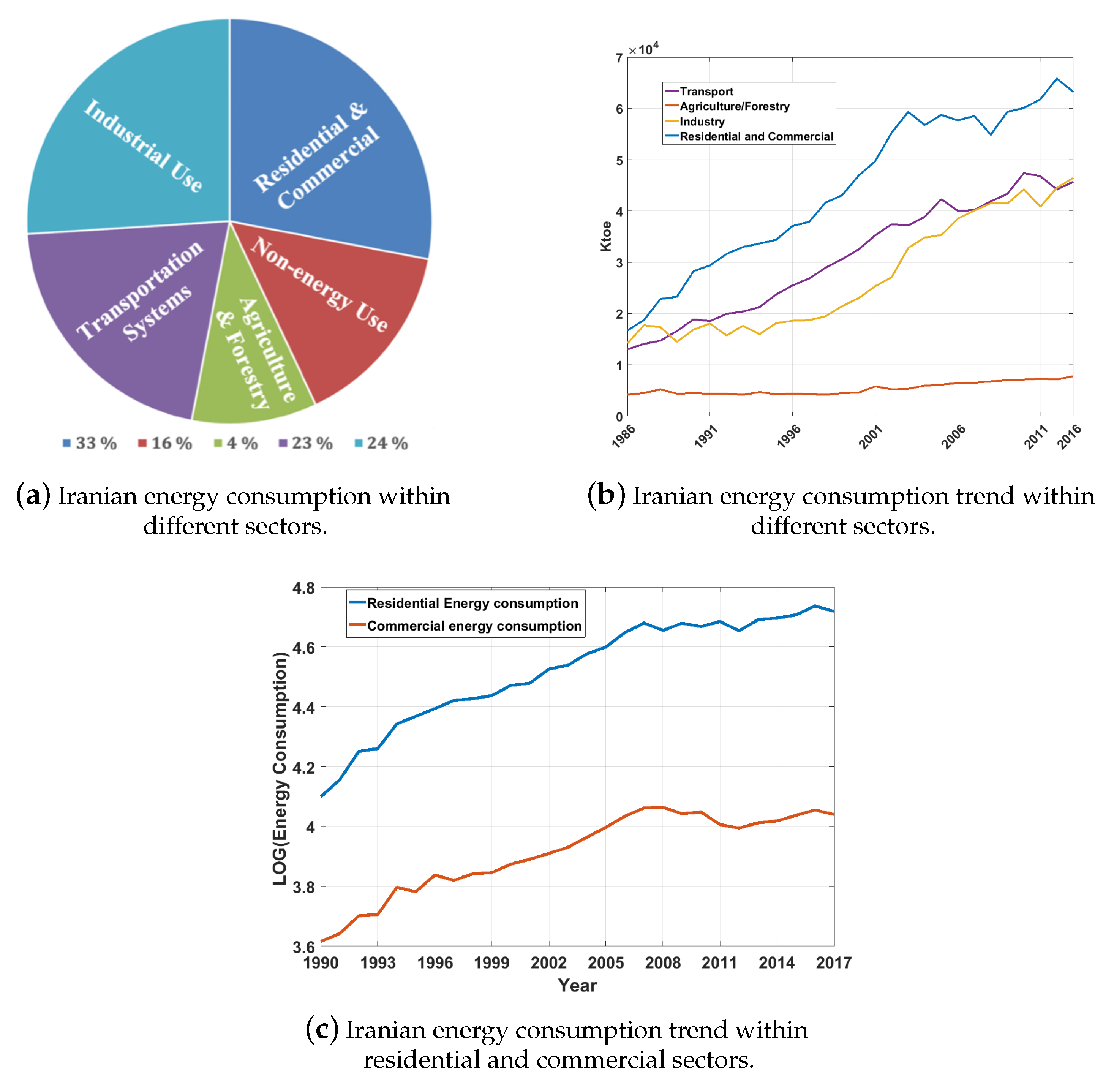
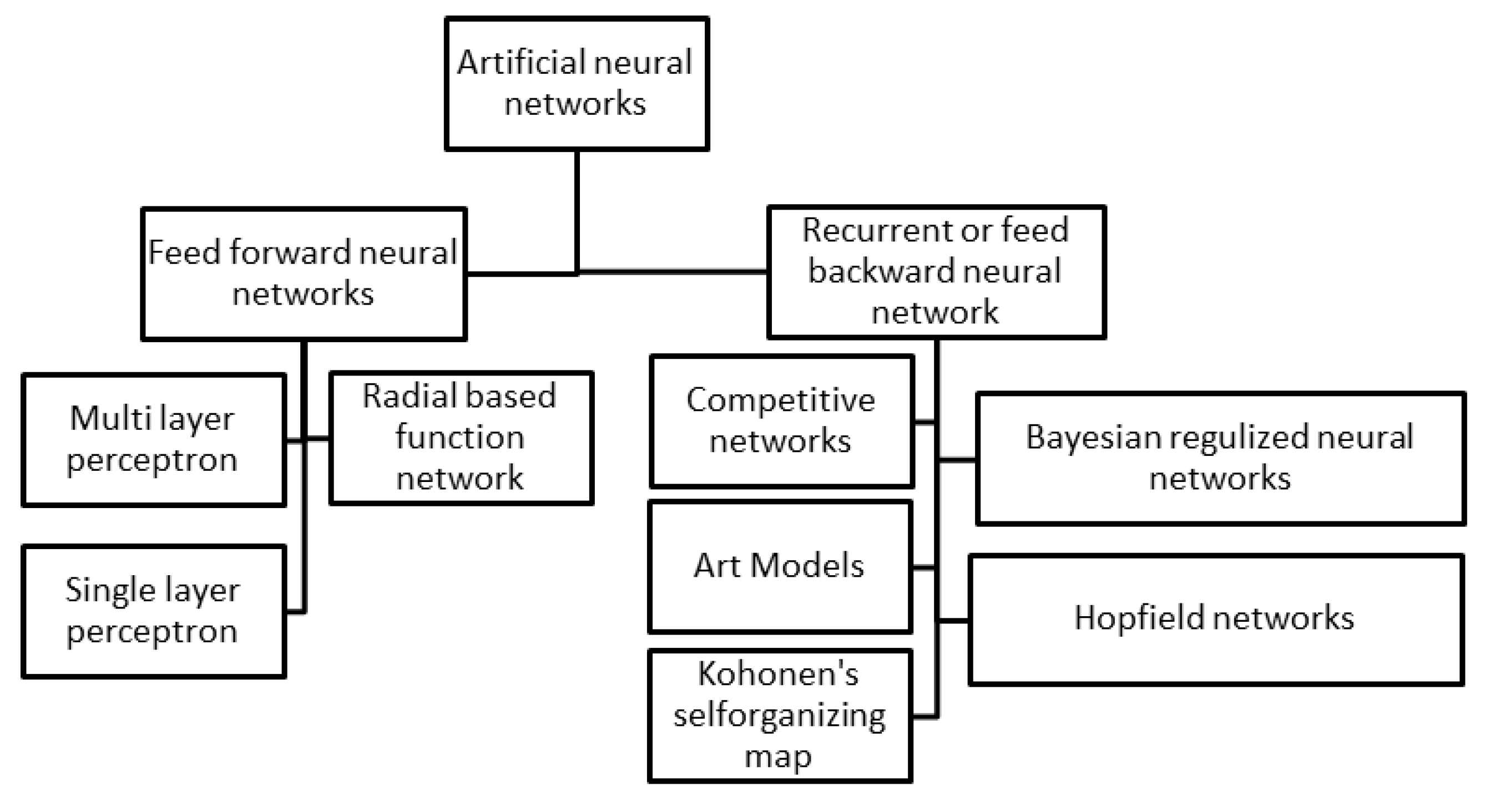
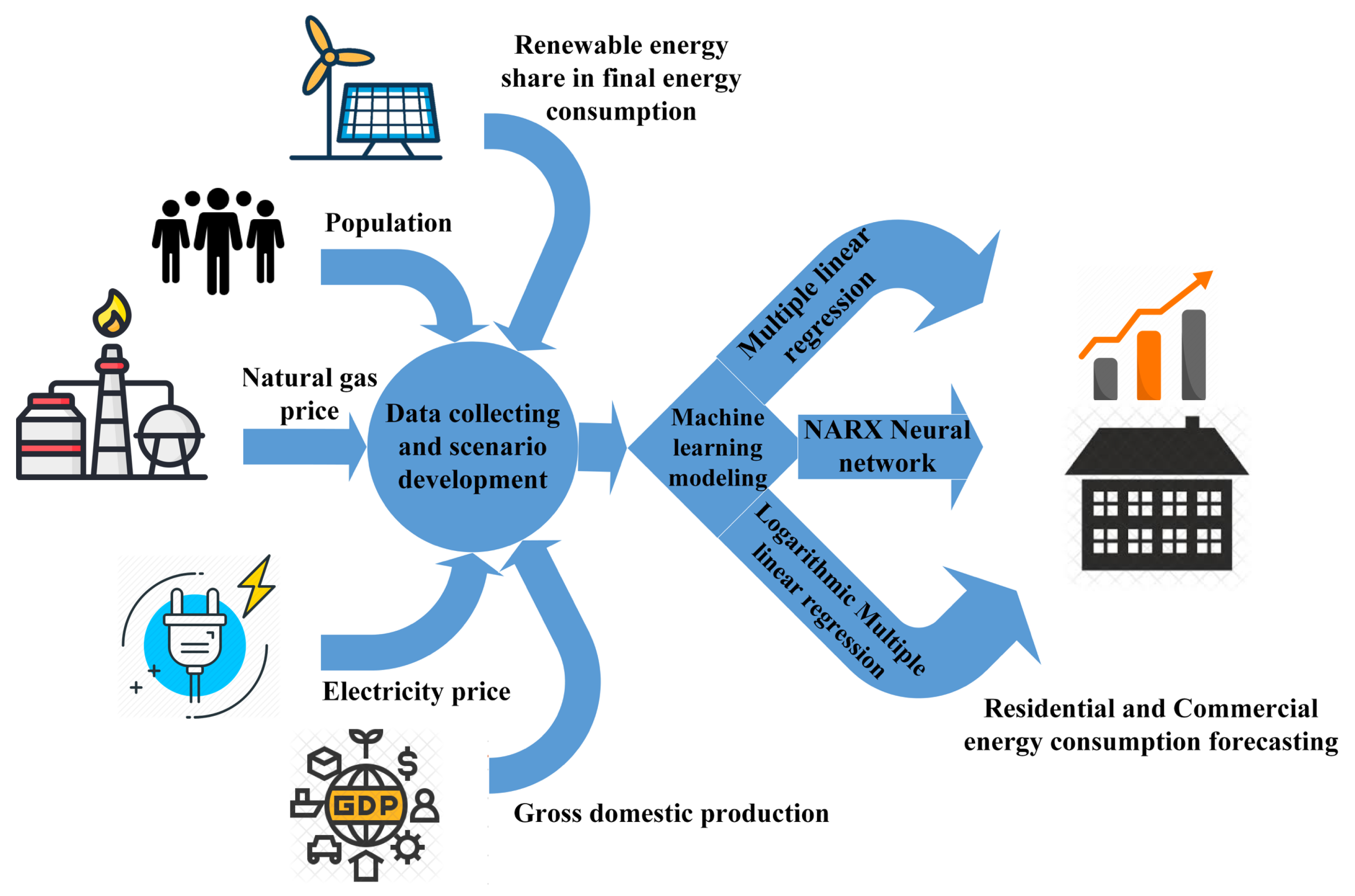
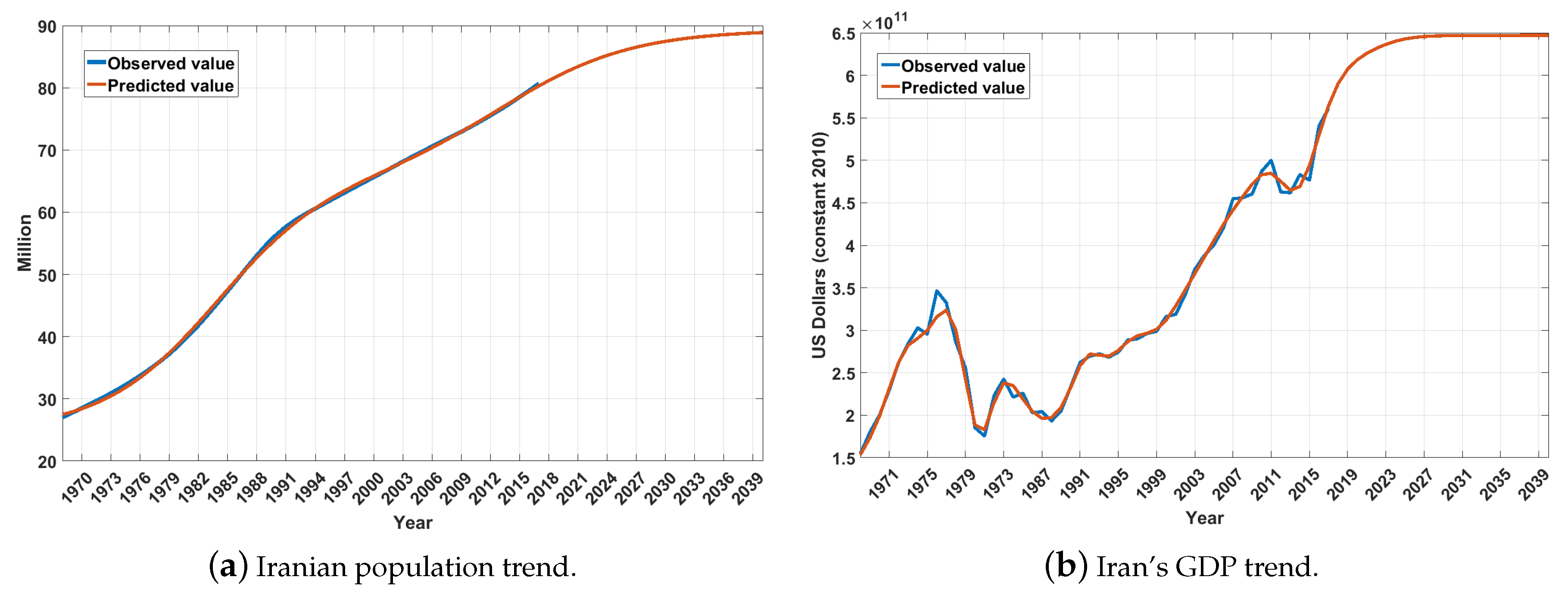
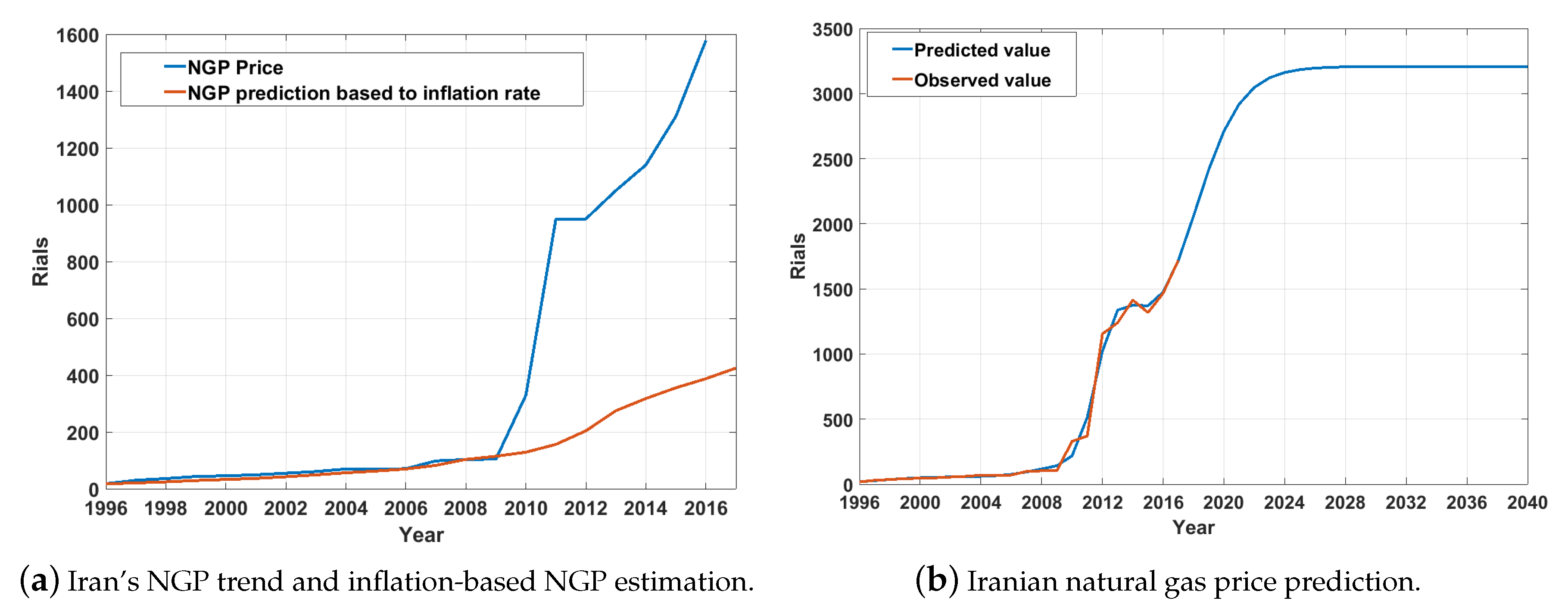
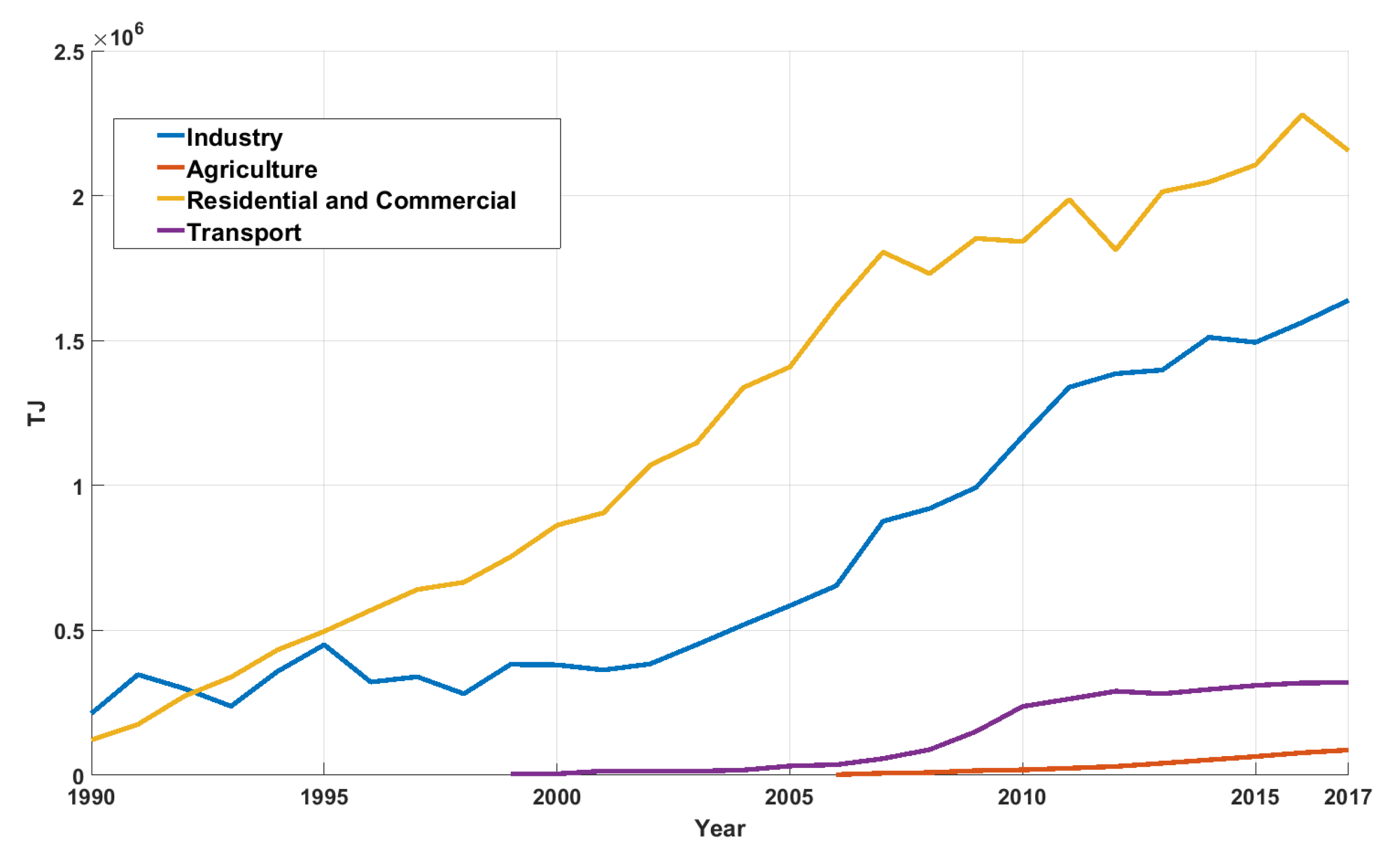
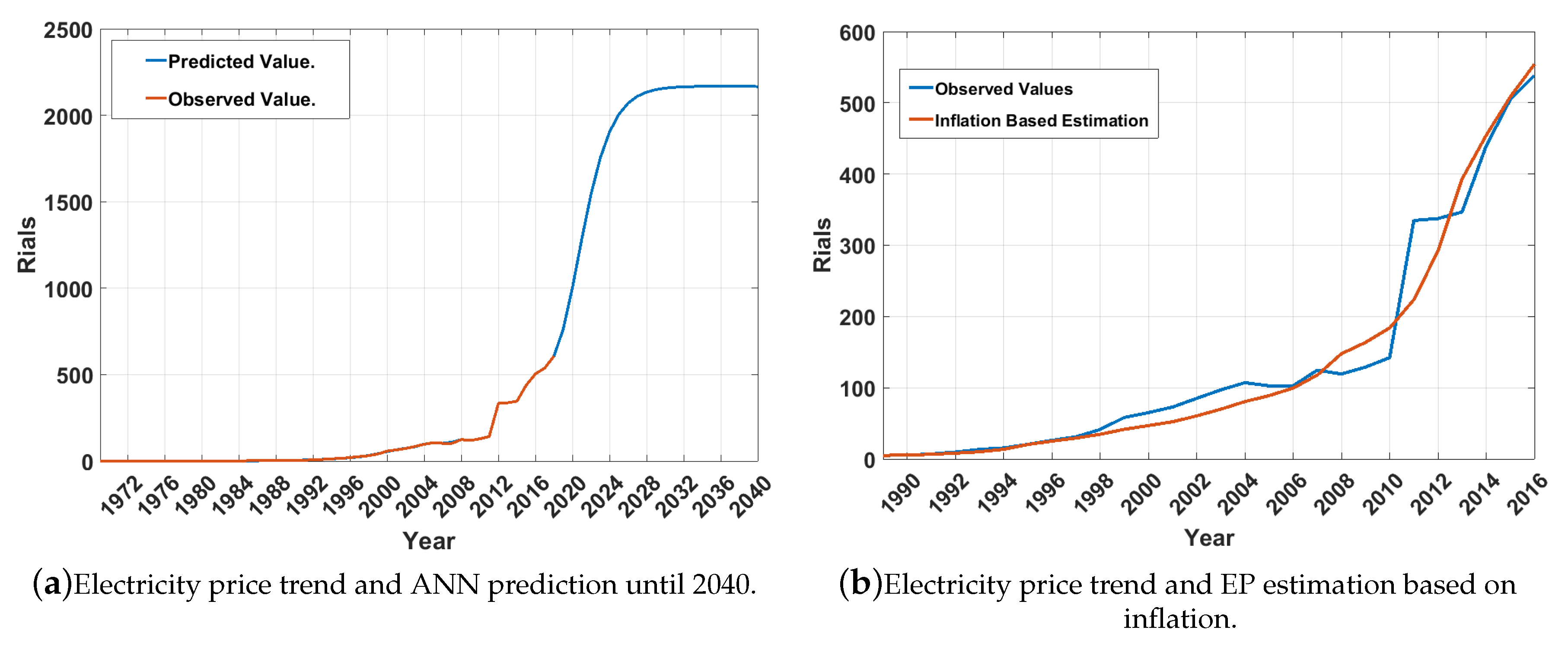
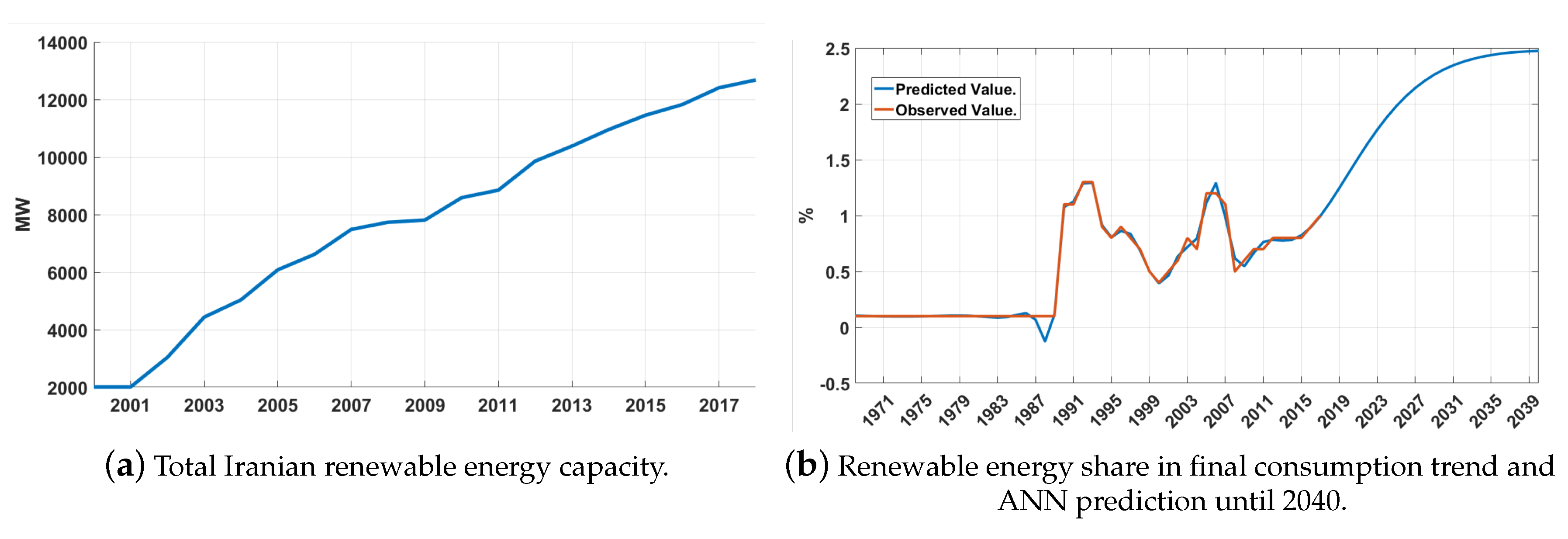
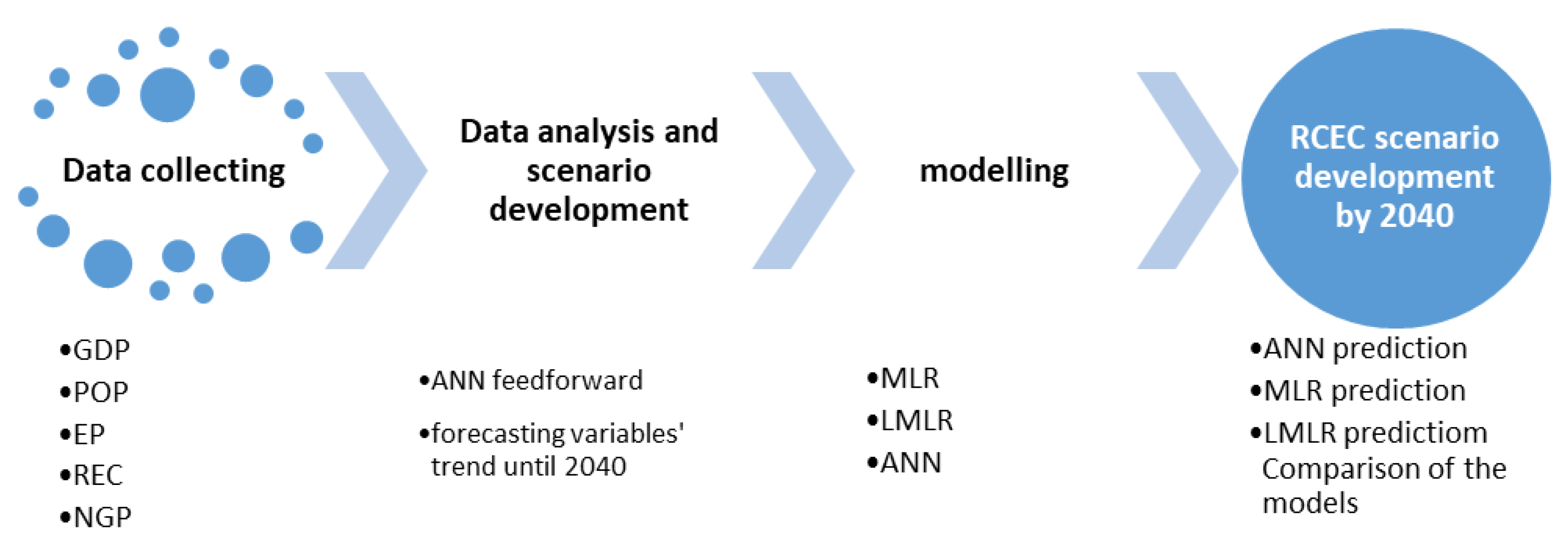
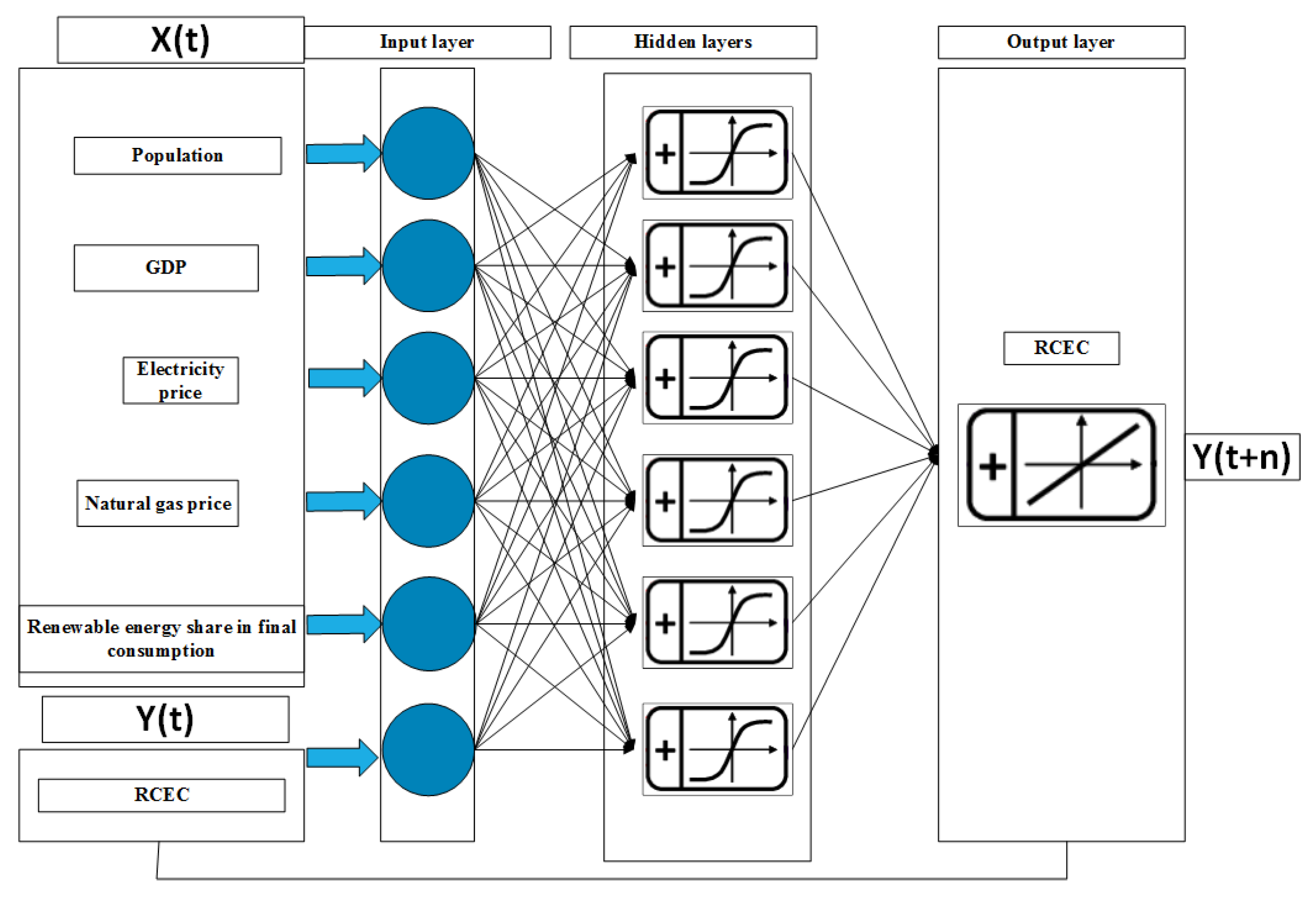
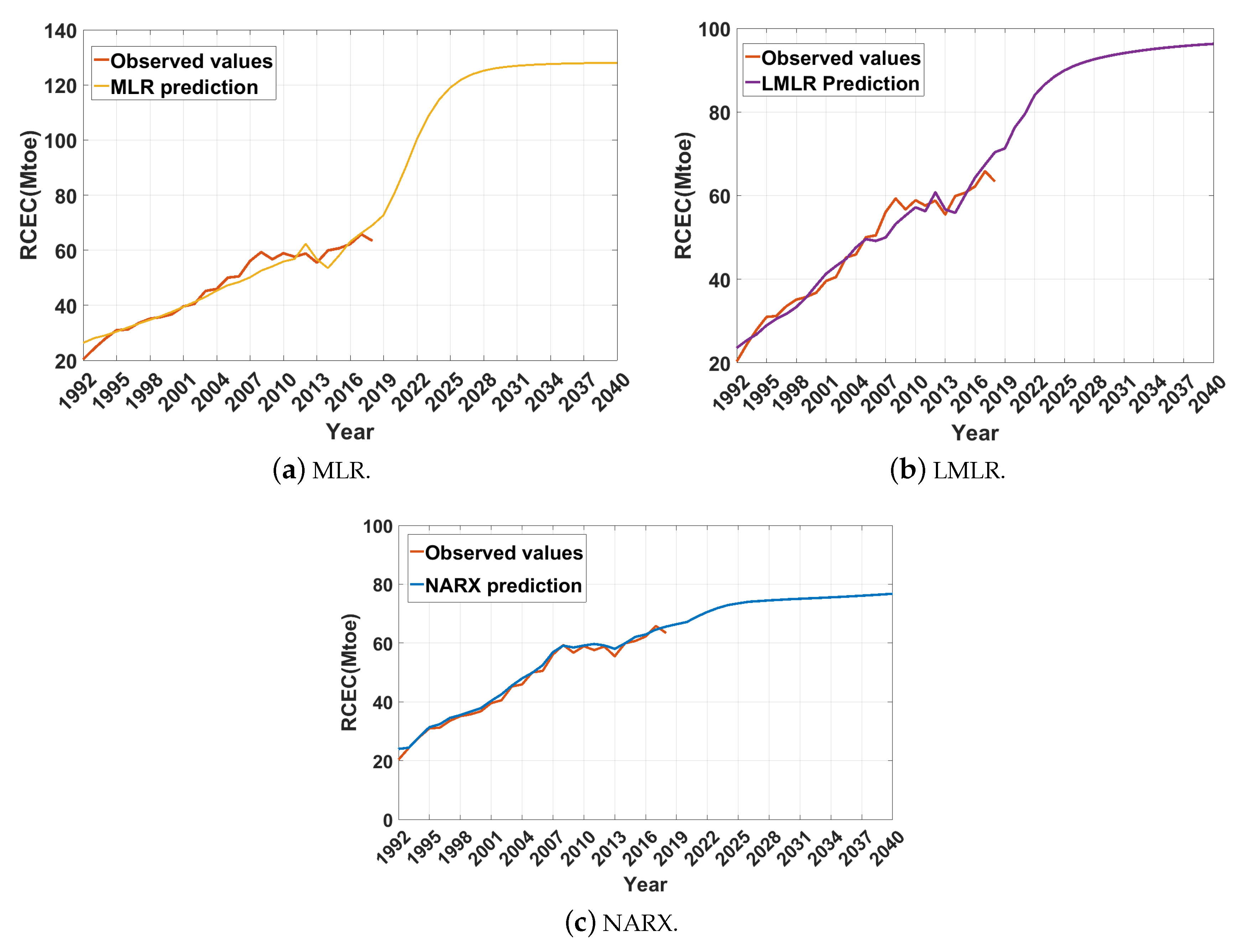
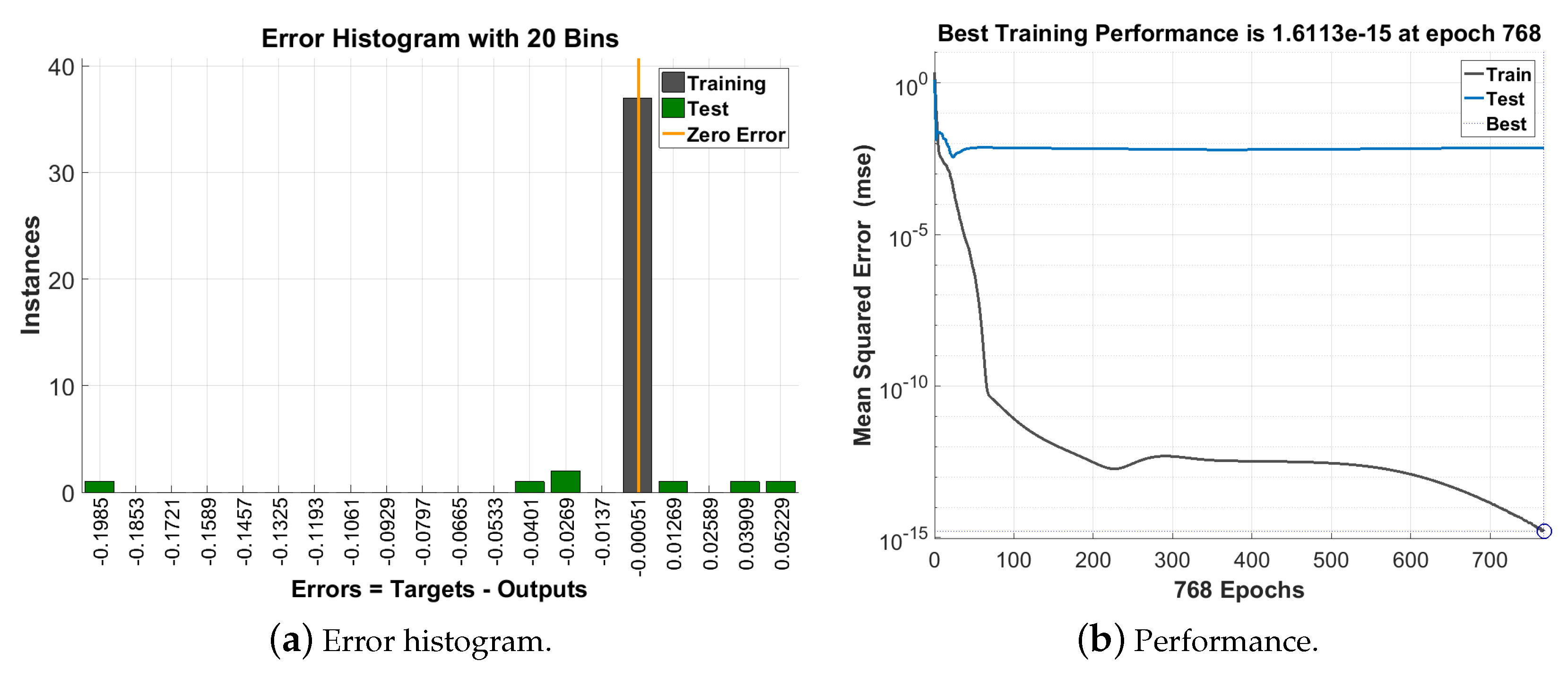
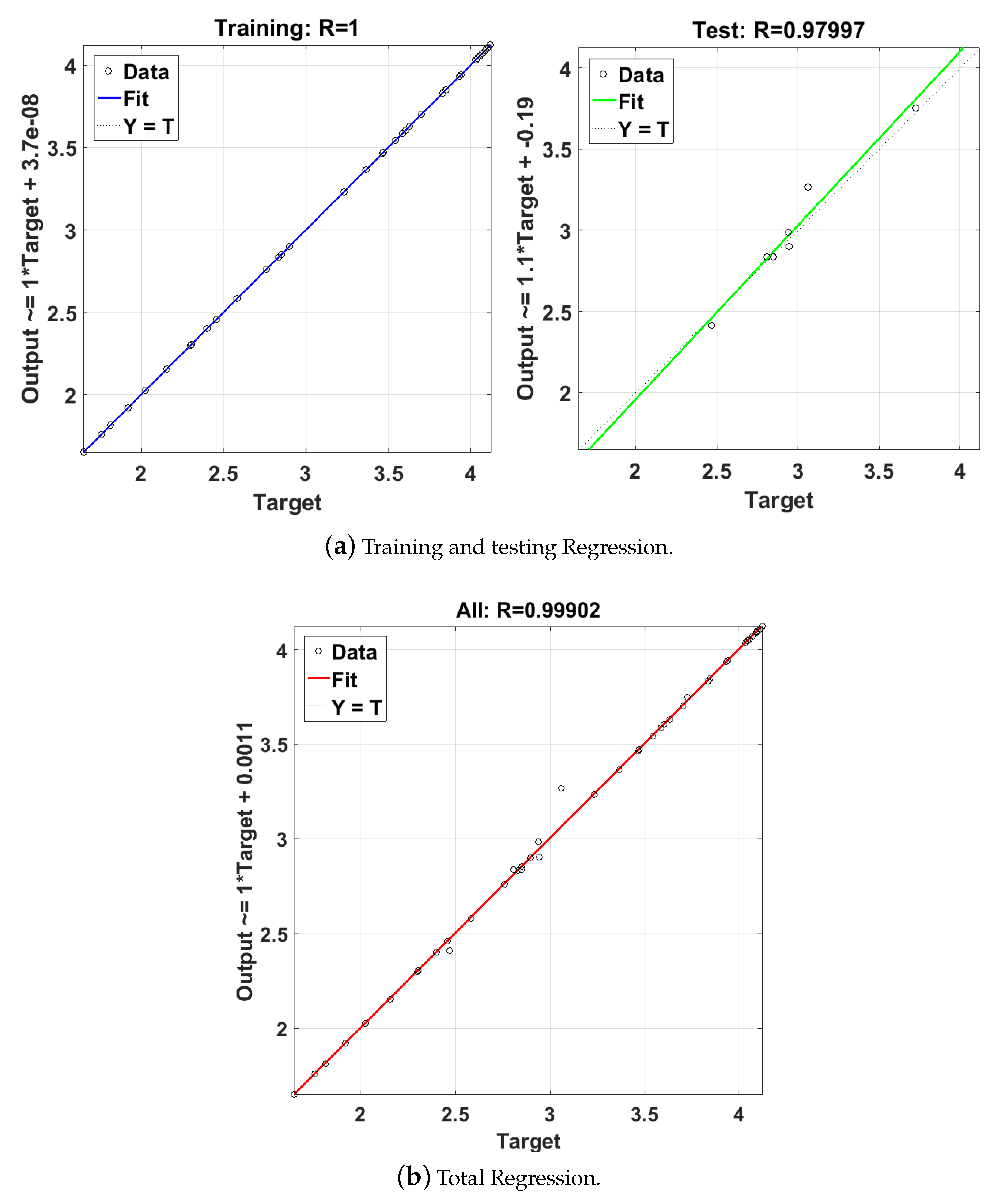
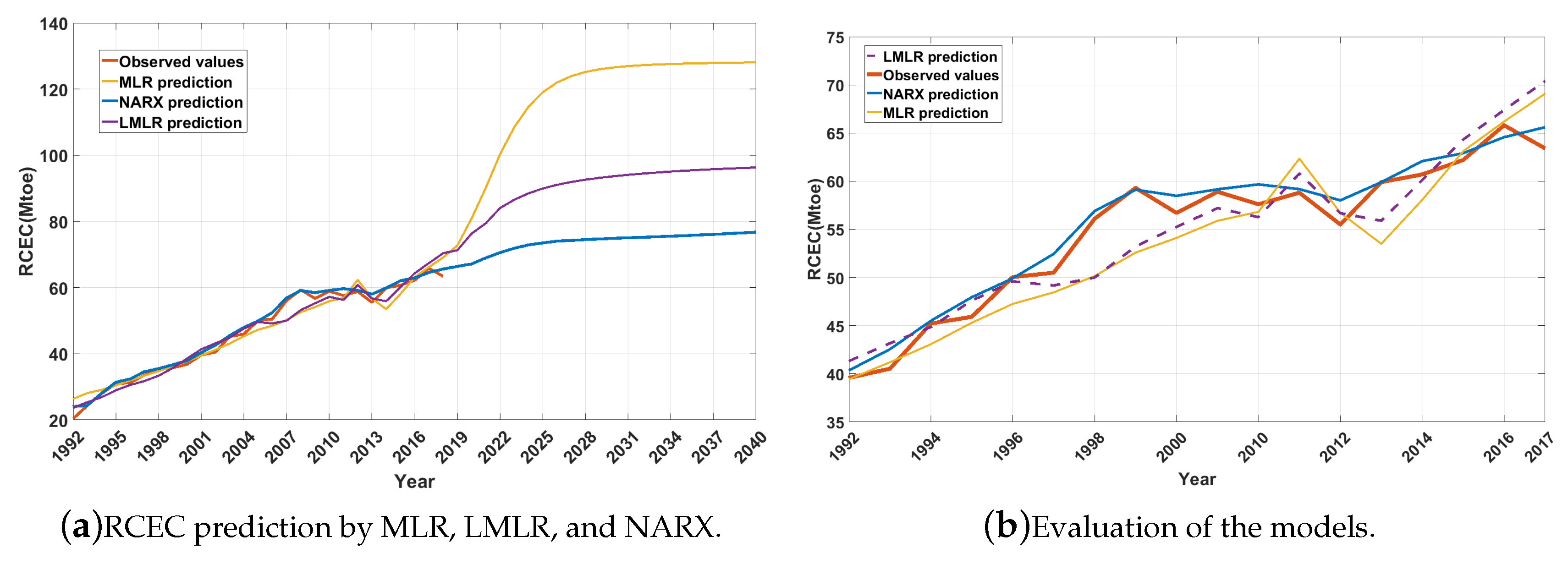
| Year | NGP | Inflation Rate | NGP According to Inflation Rate |
|---|---|---|---|
| 1991 | |||
| 1993 | 6 | ||
| 1995 | |||
| 1997 | 30 | ||
| 1999 | |||
| 2001 | |||
| 2003 | |||
| 2005 | |||
| 2007 | |||
| 2009 | |||
| 2011 | 950 | ||
| 2013 | 1050 | ||
| 2015 | 1311 | ||
| 2016 | 1578 | 9 |
| Value | ||||||
| Variable | constant | POP | GDP | NGP | EP | RESH |
| Value | ||||||
| Variable | constant | POP | GDP | NGP | EP | RESH |
| Year/Mtoe | MLR | LMLR | NARX | Observed Value |
|---|---|---|---|---|
| 2011 | ||||
| 2012 | ||||
| 2013 | ||||
| 2014 | ||||
| 2015 | ||||
| 2016 | ||||
| 2017 | ||||
| MSE | − | |||
| RMSE | − | |||
| MAPE | − |
| Method | R | MSE |
|---|---|---|
| LMLR | ||
| MLR | ||
| NARX |
© 2020 by the authors. Licensee MDPI, Basel, Switzerland. This article is an open access article distributed under the terms and conditions of the Creative Commons Attribution (CC BY) license (http://creativecommons.org/licenses/by/4.0/).
Share and Cite
Nabavi, S.A.; Aslani, A.; Zaidan, M.A.; Zandi, M.; Mohammadi, S.; Hossein Motlagh, N. Machine Learning Modeling for Energy Consumption of Residential and Commercial Sectors. Energies 2020, 13, 5171. https://doi.org/10.3390/en13195171
Nabavi SA, Aslani A, Zaidan MA, Zandi M, Mohammadi S, Hossein Motlagh N. Machine Learning Modeling for Energy Consumption of Residential and Commercial Sectors. Energies. 2020; 13(19):5171. https://doi.org/10.3390/en13195171
Chicago/Turabian StyleNabavi, Seyed Azad, Alireza Aslani, Martha A. Zaidan, Majid Zandi, Sahar Mohammadi, and Naser Hossein Motlagh. 2020. "Machine Learning Modeling for Energy Consumption of Residential and Commercial Sectors" Energies 13, no. 19: 5171. https://doi.org/10.3390/en13195171
APA StyleNabavi, S. A., Aslani, A., Zaidan, M. A., Zandi, M., Mohammadi, S., & Hossein Motlagh, N. (2020). Machine Learning Modeling for Energy Consumption of Residential and Commercial Sectors. Energies, 13(19), 5171. https://doi.org/10.3390/en13195171





